Equivalency Committee
Article Six of the Executive Regulations of Universities Law No. (49) of 1972 stipulates that the Supreme Council of Universities (SCU) forms a committee for the equivalency of academic degrees. This committee is responsible for reviewing university degrees and diplomas granted by universities and institutes not subject to Universities Law No. (49) of 1972 and its executive regulations, or other institutions, at different levels of study, and equating them with the degrees granted by Egyptian universities subject to this law and its executive regulations. Consequently, the SCU is the sole authority in the Arab Republic of Egypt responsible for the equivalency of academic degrees awarded by educational institutions not governed by the Universities Law.
On December 18, 1975, in its session extended to January 8, 1976, the SCU issued a decision delegating its president to approve the recommendations of the Equivalency Committee. The Equivalency Committee was to be composed of one representative from each university, chosen annually by the respective university council, as well as the Secretary-General of the SCU. The committee could also consult with other experts as needed.
On July 30, 2001, the SCU decided that the Equivalency Committee should be formed from the Vice Presidents for Graduate Studies and Research of Egyptian universities subject to Law No. (49) of 1972, along with the Secretary-General of the SCU, who serves as the committee’s secretary, under the chairmanship of the most senior university president.
Finally, Ministerial Decree No. 187, issued on January 27, 2010, established the General Equivalency Committee under the SCU, chaired by the Secretary-General of the SCU, with the following subcommittees:
- The Committee for Medical and Allied Sciences.
- The Committee for Sciences, Agriculture, and Veterinary Medicine.
- The Committee for Engineering and Computing.
- The Committee for Humanities, Social Sciences, Arts, and Law.
These subcommittees are composed of a select group of specialized professors in various scientific fields, with each committee headed by a designated rapporteur. The SCU’s Secretariat receives requests for equivalency of academic degrees and diplomas from individuals, universities, institutes, academies, or educational institutions not subject to Law No. (49) of 1972 and its executive regulations.
First: General Decisions Issued by the SCU Regarding Equivalency of Degrees and Diplomas Awarded by Educational Institutions Not Subject to the Universities Law:
- The first university degree granted by government universities in Arab countries is considered equivalent to the first university degree awarded by Egyptian universities in corresponding specializations.
- Doctoral degrees obtained by state-funded scholars from universities subject to the Universities Law, Al-Azhar University, or from research centers and colleges affiliated with the Ministry of Higher Education, as well as students sent abroad to obtain a doctoral degree through scholarships directly from these entities, are considered equivalent, provided certain conditions are met.
- General decisions have been made to equate certain degrees and diplomas awarded by foreign institutions with equivalent degrees granted by Egyptian universities in specific specializations, provided that the students obtained these degrees and were registered for them before December 30, 1995.
- Equivalency decisions for individuals holding degrees or diplomas from educational institutions that have received a general equivalency decision within the Arab Republic of Egypt. If the general conditions for the degree to be equated are met, an equivalency certificate is issued.
Second: In Cases Not Covered by the Above:
- A committee of specialized professors from Egyptian universities is responsible for reviewing the certificates and documents submitted for equivalency. A decision is then issued by the President of the SCU regarding the equivalency.
